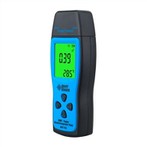Introduction to common rangefinders Classification of rangefinders
An instrument designed to measure length and distance by using the reflection and interference of light, sound, and electromagnetic waves. On the basis of length measurement, the new rangefinder can use the length measurement results to perform scientific calculations on the area, perimeter, volume, quality and other parameters of the target to be measured. It is widely used in engineering applications, GIS surveys, military and other fields. scope of application.
Introduction
The rangefinder is a tool for measuring the length or distance of a plant, and it can be combined with an angle measuring device or module to measure parameters such as angles and areas. There are many forms of rangefinder, usually a long cylinder, composed of objective lens, eyepiece, display device (can be built-in), battery and other parts.
Laser range finders can also emit multiple laser pulses to determine whether an object is moving away from or approaching a light source through the Doppler effect.
Classification
Common rangefinders can be divided into short-range [1], medium-range and elevation rangefinders in terms of range;
From the modulation object adopted by the range finder, it can be divided into: photoelectric range finder and acoustic wave range finder.
Photoelectric distance meter
According to the distance measuring method, the photoelectric range finder is divided into two types: the phase method range finder and the pulse range finder [3].
The pulse rangefinder uses a beam of light to the target object to measure the time for the target object to reflect the light back, thereby calculating the distance between the instrument and the target object. Because the laser has good directionality and a single wavelength, it is a photoelectric measurement The distance meter generally uses laser as the modulation object, so the pulse type distance meter is also commonly known as the laser distance meter.
The laser range finder using the pulse method can achieve a wide ranging range and can be used for indoor and outdoor measurements. Its typical range is 3.5 meters to 2000 meters, and the high-range laser range finder can reach 5000. meters, the laser range finder for military use can reach a farther range. Due to the ability to measure long-distance measurement targets, in order to intuitively observe the range-finding target by the user, the laser rangefinder generally has a telescopic system, which is also called a laser rangefinder telescope. The picture on the right shows three A typical diagram of a laser rangefinder telescope.
The accuracy of the laser rangefinder mainly depends on the calculation accuracy of the instrument to calculate the time between laser emission and reception. According to the technology and application used, the laser rangefinder can be divided into conventional laser rangefinders with an accuracy of about 1 meter ( Mainly used for outdoor sports, hunting, etc.) and high-precision laser rangefinders for surveying and mapping, land measurement, construction, engineering applications, military and other occasions that require high precision.
The phase method rangefinder is a rangefinder that modulates the phase of the laser light and obtains the distance by measuring the phase difference of the reflected laser light. Due to the need to detect the phase of the reflected laser, the received signal needs to have a strong intensity. Considering the safety of the human eye, the telescopic system like the pulsed laser rangefinder cannot be used, and the range is small. , the typical range of distance measurement is 0.5mm to 150 meters, the general phase method laser range finder uses 635 nanometers (visually red) laser as the debugging object, and is commonly known as infrared range finder, but in fact the definition of laser is not based on It is defined by the color, and if the 635nm laser rangefinder is directly irradiated to the human eye, it will cause irreversible damage. Readers are requested to use and protect it correctly.
Sonic distance meter
Acoustic distance measurement is an instrument that uses the reflection characteristics of sound waves to measure. Generally, ultrasonic waves are used as the modulation object, that is, ultrasonic rangefinders. The ultrasonic transmitter emits ultrasonic waves in a certain direction, and starts timing at the same time as the emission. The ultrasonic waves propagate in the air, and return immediately when encountering obstacles on the way, and the ultrasonic receiver immediately interrupts and stops timing when it receives the reflected wave. By continuously detecting the echoes reflected by obstacles after the generated waves are emitted, the time difference T between the emitted ultrasonic waves and the received echoes is measured, and then the distance L is calculated.
Since the speed of ultrasonic propagation in the air is greatly affected by temperature, humidity, air pressure, etc., the measurement error is large, and because the ultrasonic wavelength is longer, the propagation distance is shorter, so the general ultrasonic rangefinder has a relatively short measurement distance. , the measurement accuracy is relatively low. However, due to the characteristics of fan-shaped propagation of ultrasonic waves, its detection range is larger than that of photoelectric range finders, and it is widely used in safety protection, cable height measurement, obstacle detection and other fields in actual engineering.






